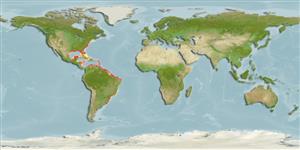Bivalvia |
Arcida |
Arcidae
Environment: milieu / climate zone / गहराई सीमा / distribution range
पारिस्थितिकी
; गहराई सीमा 0 - 68 m (संदर्भ 104365). Tropical, preferred 25°C (संदर्भ 107945); 43°N - 35°S, 98°W - 33°W (संदर्भ 3446)
Western Atlantic: from Cape Cod, Massachusetts, to the West Indies and Brazil.
Length at first maturity / आकार / Weight / Age
परिपक्व अवधि: Lm ? range ? - ? cm Max length : 7.6 cm SHL पुल्लिंग / अलिंग; (संदर्भ 78146)
Equivalved, oval in shape. Size range: 2.8-7.6 cm shell length. Shell length to height ratio = 1.16 (Ref. 78148). Shell depth reaching 70% of height (Ref. 78152).
In the USA, this species remains a potential fishery resource. From the late 1990s to early 2000s, wild stocks of this species are the target of a small-scale fishery in North Carolina (Ref. 78154) and the eastern coast of Virginia with exports primarily as ethnic food to Chicago, New York, Los Angeles and Washington D.C. (Ref. 78152). Occurs at depths ranging from the low-tide line to 3 m (Ref. 78147). Found in an estuarine environment (Ref. 104365). Found in most soft bottoms but prefers fine sand (Ref. 78148). Is a suspension feeder, discreetly motile while feeding with its ctenidia, i.e., the comb-like structure functioning as gill in bivalve mollusks (Ref. 78149). In general, suspension feeding bivalves mainly depend on phytoplankton and detritus material for nutrition (Ref. 107088).
Sexes are separate with low incidence of hermaphrodism (2.17%). Males dominant (m/f=2.68). Peak in gonadal pattern in late spring to early summer (45% ripe in May) and a minor peak in winter (21% ripe in December). Dribble spawning likely strategy to extend spawning period and increase reproductive success.
Turgeon, D.D., J.F. Quinn Jr., A.E. Bogan, E.V. Coan, F.G. Hochberg, W.G. Lyons, P.M. Mikkelsen, R.J. Neves, C.F.E. Roper, G. Rosenberg, B. Roth, A. Scheltema, F.G. Thompson, M. Vecchione and J.D. Willams 1998 Common and scientific names of aquatic invertebrates from the United States and Canada: Mollusks, 2nd ed. American Fisheries Society (Special publication 26), Bethesda, Maryland. 526 p. (संदर्भ 1667)
IUCN Red List Status
(संदर्भ 130435: Version 2025-1)
CITES status (संदर्भ 108899)
Not Evaluated
CMS (संदर्भ 116361)
Not Evaluated
Threat to humans
Harmless
Human uses
मात्स्यिकी: लघु वाणिज्य; जलीयकृषि: प्रयोगात्मक
FAO - मात्स्यिकी: landings | FishSource | Sea Around Us
साधन
अधिक जानकारी
PhysiologyOxygen consumption
Human RelatedStamps, coins, misc.
इंटरनेट स्रोत
Estimates based on models
Preferred temperature
(Ref.
115969): 14.5 - 28, mean 25.4 (based on 490 cells).
लौटाव
ऊंचा, न्यूनतम जनसंख्या दुगनी समय अवलागत 15 महीने। (K=0.45; tm=5).
Fishing Vulnerability
Moderate vulnerability (37 of 100).
Climate Vulnerability
Moderate to high vulnerability (55 of 100).
Nutrients : Calcium = 149 [71, 228] mg/100g; Iron = 8.53 [1.95, 15.11] mg/100g; Protein = 9.88 [8.64, 11.12] %; Omega3 = 0.313 [0.202, 0.423] g/100g; Selenium = 61 [50, 72] μg/100g; VitaminA = 0 μg/100g; Zinc = 2.04 [0.56, 3.51] mg/100g (wet weight); based on
nutrient studies.
